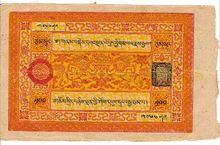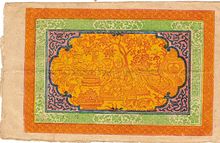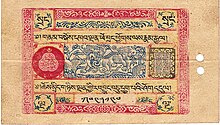Tibetan paper money
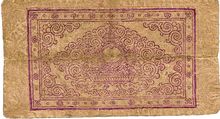
The Tibetan paper money was in Tibet , at the suggestion of the 13th Dalai Lama , Thubten Gyatso prepared in 1912, the use of paper as a means of payment had met in his Indian exile in the years 1910 to 1912. The first issue of the banknotes took place in January 1913, after his return to Lhasa . The last printing of Tibetan banknotes took place in 1959, afterwards the production of Tibetan money was stopped under pressure from China , after the minting of Tibetan coins had been stopped years before as part of the Chinese occupation . Because of its high-quality artistic design, Tibetan paper money is now a sought-after collector's item for numismatists .
history
By hand or with the simplest of machines, banknotes of 5 and 10 tam , the Tibetan currency unit , which is often referred to as tamga or “tangka” in Western literature, were first printed using wooden printing blocks. These were dated 1658 of the Tibetan calendar of the Bot Gyalo (Tibetan bod rgyal lo ). This year corresponds roughly to the year 1912 AD (strictly speaking, it comprised the period from February 19, 1912 to February 6, 1913 inclusive). A little later, the values 15, 25 and 50 tam with the date 1659 were added, as well as further 10 tam notes with the new date. Depending on requirements, the banknotes were also printed in the following years, but always with the year 1659. Except for the 5-tam notes, which all bear the date 1658.
In 1926 the 50 tam notes, which were initially colored blue, were replaced by multicolored notes of the same face value, while the remaining values of the first banknote series were withdrawn from circulation in 1934 and only replaced by new banknotes from 1939/40. The early banknotes and the multi-colored 50-tam notes, first issued in 1926, were probably handcrafted in the government printing plant in Shol, below the Potala Palace . Probably from 1926 banknotes of the series of the currency unit Tam were also printed in the Mint Dode (Tibetan dog bde or dog de ), located about 15 kilometers northeast of Lhasa.
After the expansion and modernization of the Mint Grva bzhi glog 'krul las khung , the "Trabshi Electrical Machine Workshop", the multicolored banknotes with the face value of 50 Tam began to be printed in larger quantities in 1931 using machines imported from British India . These were made with metal printing blocks, with a separate printing block for each color. Only the four-line Tibetan text on the front of the notes was printed with wooden printing blocks. The multi-colored 50 tam notes are dated according to both the traditional Tibetan calendar and a Tibetan cyclical calendar . This dating was also used for Tibetan coins, first for the so-called Kong Par Tangkas. However, the year dates in the Tibetan calendar are more precise, because only the cycle (15th or 16th cycle) was indicated without mentioning the year within the cycle. There are multi-colored 50-tam notes with 16 different dates ranging from 1672 (1926) to 1687 (1941).
New, undated notes with the high face value of 100 Tam Srang were introduced in 1939 and 1940. The Tibetan Srang is a unit that originally weighed around 37 grams of silver. 6⅔ Tam corresponded to 1 Srang. Only 50,000 of these notes were issued, after which only slightly changed notes with the nominal value of 100 Srang (instead of 100 Tam Srang) were produced. From 1941 notes of 10 rang were introduced. These are available with different dates in the Tibetan calendar and range from 1687 (1941) to 1694 (1948). Between 1942 and 1945 there were also small, undated notes with a face value of 5 Srang. The last note introduced in Tibet had a face value of 25 Srang. It is undated and was published between 1950 and 1955. The undated 100-Srang notes were printed until 1959, after the production of Tibetan coins for Chinese printing had long since ceased.
Numbering of banknotes
All Tibetan banknotes were numbered by hand, including the later machine-printed notes. For this purpose, young people were specially trained in calligraphy. Since the young men mostly came from the province "E", the calligraphers were called "e-ba" or "i-drug-pa". The young copyists received their training in an office located within the Potala called "e-khang" and learned how to write government documents with correct calligraphy. For those who did not get this special training, it is almost impossible to exactly imitate the numbers written on the notes. Therefore, fake notes can often be recognized at first glance by the amateurish spelling of the serial numbers. The multi-colored 50 Tam and the later 5 and 10 Srang notes have double perforations on the right edge. With the help of this device, the notes could be bundled into 10 or 20 pieces each.
Seal on the banknotes
Usually the banknotes have a red and a black seal imprint . The red seal is supposed to represent the authority of the Dalai Lama and has no or an illegible inscription. Four different types of red seals were used. A few early banknotes have survived, especially notes of 5 tam on which a seal imprint is missing or both imprints are missing. It is not certain whether such notes were accidentally brought into circulation or whether they were proofs or unfinished notes that came into circulation without authorization.
The black seals, which were used in the early editions in Tam and in the multi-colored 50-Tam notes, have a Tibetan inscription, which is legible in the square script ( Phagspa script ) developed by Phagspa Lodro Gyaltshen (1235–1280) . Three different black seals were used:
- The inscription is set in two columns: gzhung and dgnul khang, respectively . The literal translation of this inscription is "Government Silver House". However, dngul-khang has the meaning of "bank", so the word gzhung dngul khang has to be translated as "state bank".
- A smaller black seal with the same inscription in two columns in square script was used for the 5 and 10 rang notes.
- For the later editions of the 25 and 100 Srang notes, a black seal with square letters in two columns was used, which is to be transcribed as follows: srid zhi / dpal 'bar . Several interpretive translations are proposed for this inscription:
- "Every form of existence increases the good"
- "Two Glorious Governments"
- “The glory of both government houses” - what is meant here is the secular and religious authority that is united in the Dalai Lama, or the Tibetan form of government that is both secular and spiritual
- "Peaceful Government Brings Prosperity"
In a government document announcing the issuance of 100-Srang notes, it is mentioned that this seal can be assigned to the government mint Trabshi Lekhung. It was used on the 100 and 25 Srang notes and occurs in several variants, which are reflected in the design of the four ornamental mushrooms to the left and right of the corners of the inner rectangular part of the seal and in the design of the four stylized Vajras ( rdo rje - “Thunderbolt”) outside the central rectangle.
Inscriptions
First series

Various inscriptions can be found on the notes, for example on the front of all banknotes of the first series of 5, 10, 15, 25 and 50 tam, as well as on the multi-colored printed 50-tam notes and on the 10-rang notes the following Quatrain:
"Gangs ljongs bod rgyal khab chen po'i lugs zung chab
Srid dbu brnyes kyi lo chig stong drug brgya lnga bcu nga brgyad
Phun tshogs sde bzhi'i dpal mnga 'phan bde'i spyi nor
Chos srid gnyis ldan gyi rab byung bco lnga ba'i shog dngul. "
Martin Brauen suggests the following translation: “One thousand six hundred and fifty-eight years since the beginning of the two-part legal rule in the mighty snowy land of Tibet. Paper money in the fifteenth Rabjung for the benefit and piety of the general public and the rule of the four good qualities (health of the body, belongings, good submission and scribalism), which includes both the spiritual and the secular. "
It should be noted that the year in the second line varies depending on the year of issue, with the early notes only showing the year 1658 and 1659, the multi-colored 50-tam notes from 1672 to 1687 and the 10- Srang notes 1687 to 1694 of the Tibetan calendar. In the last line the indication of the cycle (rab byung) varies , which is the fifteenth of all early notes, the fifteenth of the first multi-colored 50-tam notes dated 1672, and the other colored 50-tam notes (ab 1673) as well as the sixteenth cycle of the 10-rang notes.
25 and 100 rang notes
On the notes for 25 and 100 rang there is the inscription:
"Gnam bskos dga 'ldan pho brang phyogs las rnam rgyal
Chos srid gnyis ldan gyi shog dngul srang brgya tham pa (or nyi shu rtsa lnga for 25 Srang)"
The translation of this sentence means: “From the Ganden Palace established by heaven , which is victorious in all directions. One hundred (twenty-five) paper-silver-rang. ”The first line of this legend also occurs in abbreviated form, without the first two syllables“ gnam bskos ”,“ inserted from heaven ”, on all coins of Tibet. Except for what is called the Sino-Tibetan editions. The Ganden Palace is located in Drepung Monastery west of Lhasa and served as the residence of the third, fourth and fifth Dalai Lamas until the latter moved to the newly built Potala Palace in the 17th century. The term "Ganden Phodrang" has been used to describe the Tibetan government since the time of the fifth Dalai Lama.
5-strand notes

The following two-line inscription can be found on the notes with the face value 5 Srang:
"Gnam bskos dga 'ldan pho brang phyogs las rnam rgyal
Chos srid gnyis ldan gyi rab byung bcu drug pa'i shog dngul"
The translation for this is: “From the Ganden Palace set up by heaven, which is victorious in all directions. Paper money of the sixteenth cycle of spiritual and secular government. "
Security legend
In addition to these inscriptions on the front of the notes, there is also a secret legend inside the banknotes. Tibetan banknotes consist of two layers of paper made from local raw materials, which were glued together before printing. With the early notes, a third piece of paper was glued between the two main layers of paper. This additional paper carried the secret or security legend. With later notes of the Srang series, the third paper was usually saved and the secret legend was printed on the inside of the front of the notes instead. The secret legends, which have a similar function to watermarks on modern banknotes, take up the wording of the inscriptions on the face of the notes in a shorter form.
The following two-line security key is included in all banknotes with the exception of the 5-strand issue as security key. You can read this by holding a note up to the light, with the front facing the viewer:
"Gnam bskos dga 'ldan
pho brang phyogs las rnam rgyal"
The notes to 5 rang have the following one-line safety legend, which is nothing more than a greatly abbreviated version of the above-cited inscription:
"Dga 'ldan pho brang"
Vertical inscription
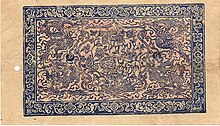
Finally, all notes with Srang as face value also have an inscription in two columns in square script, which is located on the front of the 5-, 10- and 25-Srang notes on both sides of the rectangle, which is the central motif framed. For the 100-rang notes, this legend appears on both sides of the rectangle that frames the main motif on the back of the note. This legend reads for all mentioned notes:
"Dga 'ldan / pho brang
phyogs las rnam rgyal"
Representations on the banknotes
On the front of all notes the main motif is a snow lion or a pair of these mythological animals, which are emblematic of Tibet. The back of the notes is adorned with other mythological animals or motifs that are predominantly related to Buddhism or go back to Chinese mythology, for example the motif of the six symbols of long life (Tibetan: tshe ring drug skor ) on the blue 50 tam and den 100 Srang notes. The design of the Tibetan banknotes is at a high artistic level and has contributed to the fact that these have become coveted collector's items today.
Editions and issues
Approximate print run and year of issue or year of manufacture of banknotes circulating in Tibet:
| Face value | Issue years | Number of copies |
|---|---|---|
| 5 tam | 1912/13 to 1932 | 40,000 |
| 10 tam | 1912/13 | 5,000 |
| 10 tam | 1913 to 1932 | 20,000 |
| 15 tam | 1913 to 1932 | 15,000 |
| 25 tam | 1913 to 1932 | 70,000 |
| 50 tam (solid blue) | 1913 to 1926 | 70,000 |
| 50 tam (multicolored) | 1926 to 1941 | 1,200,000 |
| 5 rang | 1941 to 1946 | 134,500 |
| 10 Srang | 1941 to 1948 | 723,600 |
| 25 Srang | 1950 to 1955 | 700,000 |
| 100 Tam Srang | 1937 to 1939 | 50,000 |
| 100 rang | 1939 to 1945 and 1951 to 1959 | 1,280,000 |
literature
- Wolfgang Bertsch: Exotic paper money from Tibet. In: Der Geldscheinsammler , 8, 6, pp. 6–11 and 8, 7, pp. 12–21. 1994
- Wolfgang Bertsch: A Study of Tibetan Paper Money , Library of Tibetan Works and Archives, Dharamsala, 1997
- Wolfgang Bertsch: The Currency of Tibet: A Sourcebook for the Study of Tibetan Coins, Paper Money and other Forms of Currency . Library of Tibetan Works and Archives, Dharamsala, 2002
- Wolfgang Bertsch: The Paper Currency of Tibet , Thyaka Research Center, Gundernhausen near Darmstadt and Lalitpur (Nepal), 2013
- Martin Brauen: Heinrich Harrer's impressions from Tibet . Innsbruck and Frankfurt am Main, 1974
- Karl Gabrisch: Money from Tibet . Collection Dr. Karl Gabrisch Winterthur and Rikon, 1990
- Günter Grosch: Tibet and its monetary history. In: Geldgeschichtliche Nachrichten , 2, 5, pp. 8–12 and 2, 6, pp. 54–57 and 2, 7, pp. 92–94 and 2, 10, pp. 61–66. 1967/68
- Colin Narbeth, Gylfi Snorrason: Catalog of Tibetan Paper Money , Geoffrey Flack, Vancouver, 2001
- Charles K. Panish: Tibetan Paper Money. In: Whitman Numismatic Journal , 5, 4, pp. 467-471 and 5, 5, pp. 501-508, 1968
- Nicholas G. Rhodes: The Dating of Tibetan Banknotes. In: The Tibet Journal , 13, 1, pp. 57-60, 1988
- Bhupendra Narayan Shrestha: Tibetan Paper Currency . St. Albans, Herts, 1987.
- Huaiyuan Xiao: Xi zang di fang huo bi shi (The History of Tibetan Money) Beijing, 1987
- Jinzhong Zhu, Ping-cuo Ci-ren, Lunzhang Yan: Yuan xi zang fang bi gai kuang (General Introduction to Tibetan Local Currency ), People's Bank of China Finance Department, Tibet Autonomous Region Branch, Lhasa, 1988
- Jinzhong Zhu, Haiyan Wang, Jiafeng Wang, Wuyi Zhang, Hanlin Wu, Dui Wang, Pincuo Tsering: Zhong guo xi zang qian bi (The money of Chinese Tibet), Xi zang zi zhi ou qian bi xue hui (Tibet Autonomous Region Numismatic Society ), Zhong hua shu ju, Beijing, 2002
See also
Individual evidence
- ↑ One tam corresponds to a coin with ⅔ silver content weighing around 5.4 grams, cf. Friedrich Schrötter: Dictionary of Coin Studies , Walter de Gruyter, 1970, section “Tangka”, p. 679, ISBN 3110012278 .
- ↑ Also known as the Tibetan era . The first year of this Tibetan calendar corresponds to the year 255 of the western calendar. According to the inscription on the banknotes, this was the year the first Tibetan ruling dynasty was founded.
- ↑ This facility is usually called "Trabshi Lekhung" for short in Western literature and was located two kilometers north of the old town of Lhasa. The Chinese occupiers built a prison on the same site after 1959.
Web links
- Wolfgang Bertsch: A Survey of Tibetan Paper Currency. In: Bulletin of Tibetology , 3, pp. 3-22, 1996.
- PDF at himalaya.socanth.cam.ac.uk
- Bank Note Museum - TIBET








